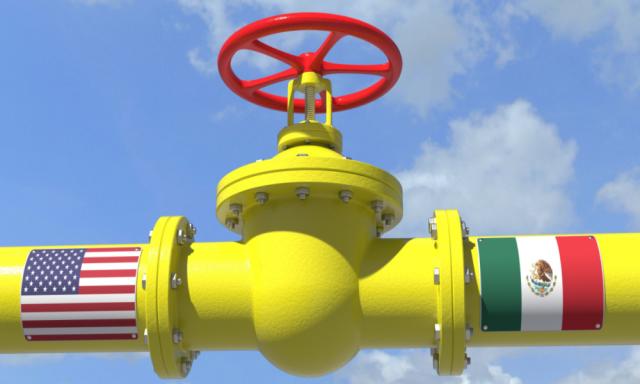
Mexico’s piped gas imports from the U.S. in April reached 5.86 Bcf/d, up 7% sequentially compared to March but down 4% compared to the same year-ago month, according to EIA data. (Source: Shutterstock.com)
Mexico’s demand for piped natural gas imports from the U.S. remains robust amid insufficient domestic supply and strong demand from power plants and as the country shies away from the higher-priced LNG cargoes.
The lack of domestic gas supply in Mexico is in part due to the nationalistic policies of President Andres Manuel Lopez Obrador, which have deferred investments to projects such as the Dos Bocas refinery in Mexico and the Deer Park refinery in Texas, and away from domestic upstream projects with potential to boost gas supply.
Consequently, Mexico’s state-owned Petroleos Mexicanos (Pemex) and private players continue to struggle to boost gas production to meet rising domestic demand primarily from natural gas-fired power plants, the country’s main source of electricity production, the U.S. Energy Information Administration wrote July 13 in an update on its website.
Piped Gas Imports
Mexico’s piped gas imports from the U.S. in April reached 5.86 Bcf/d, up 7% sequentially compared to March but down 4% compared to the same year-ago month, according to Energy Information Administration (EIA) data. In the study period spanning 2019-2022 (April of this year), Mexico’s demand for imports of U.S. piped gas peaked at 6.61 Bcf/d in June 2021 while they reached a low of 4.62 Bcf/d in April 2020 amid the onset of the COVID-19 pandemic.
Average U.S. piped gas imports between January-April averaged 5.62 Bcf/d, and are up 4% compared to December 2021. However, the volumes are flat with the same four-month period in 2021 but up compared to similar timeframes in 2020 and in 2019 pre-pandemic.
Gas-fired plants generated 62% of Mexico’s total electricity in 2021, up from 54% in 2015 and 34% in 2005, the Washington-based agency said, adding that renewable generation from hydropower, wind, solar, biomass and geothermal energy sources rose to 25% of total generation in 2021 compared to 16% in 2017. Combined generation by fuel oil and coal fell to 9% in 2021 compared to 24% in 2017, the agency said.
Looking forward to the next four years (2022–2025), “Mexico will continue to expand both natural gas-fired and renewable electric generation capacity,” the EIA wrote last week, referring to forecasts from Mexico’s Energy Secretariat or Sener.
The bulk of the U.S. piped gas imports reach Mexico via four primary entry points off Texas’ southwesternmost border with Mexico including Camargo (in Mexico’s Chihuahua state), Matamoros (Tamaulipas state), Ojinaga (Chihuahua state) and Reynosa (Tamaulipas state), and in that order, according to Sener data published in May.
Mexico’s demand for U.S. gas has only continued to rise over the last 11 years and to the benefit of U.S. shale producers. In 2021, these imports reached 5.90 Bcf/d, the highest market during 2010-2021 compared to 5.45 Bcf/d in 2020 and just 0.91 Bcf/d in 2010, according to EIA data.
Mexico’s Rising Pipe Gas Imports from the U.S. (Bcf/d) |
|
| 2021 | 5.90 |
| 2020 | 5.45 |
| 2019 | 5.11 |
| 2018 | 4.63 |
| 2017 | 4.19 |
| 2016 | 3.77 |
| 2015 | 2.89 |
| 2014 | 2.00 |
| 2013 | 1.80 |
| 2012 | 1.70 |
| 2011 | 1.37 |
| 2010 | 0.91 |
“The Mexican government’s escalating pursuit of discriminatory policies that favor state-run energy companies and hinder private sector investment directly threatens the prosperity of U.S. companies and their workers,” American Petroleum Institute President and CEO Mike Sommers and American Clean Power Association (ACP) CEO Heather Zichal announced July 20 in a joint statement.
The comments from the two U.S. executives came after the Office of the United States Trade Representative said it would request formal consultations with Mexico under the United States-Mexico-Canada Agreement (USMCA) related to Lopez Obrador’s energy sector policies.
LNG Imports
Mexico also turns to LNG imports to assist cover its scarcity of gas supply in the domestic market. However, the country’s reliance on LNG has been on a downward trend during the shorter study period of 2019-2022 (March this year) owing primarily to rising LNG prices and an increasing preference for U.S. piped gas amid an abundance of supply in the North American country.
Mexico’s imports of LNG reached 14 MMcf/d in March, their lowest point over the study period, down 33% sequentially compared to February and down 75% compared to the same year ago month, according to Sener data. In February 2021, Mexico imported a record 276 MMcf/d before starting a generalized downward import trend.
During the same 2019-2022 (March) study period, Mexico’s imports of LNG peaked at 979 MMcf/d in June 2019.
LNG prices this year have soared above prices for diesel, LPG and fuel oil and hampered the attractiveness of the energy source in Mexico. For instance, the LNG reference prices in April in Altamira and Manzanillo in Mexico were $28.46/MMBtu and $29.19/MMBtu compared to $31.62/MMBtu in Spain and $31.93/MMBtu in Turkey, according to Sener data. In comparison, the price in April in Cove Point in the U.S. was $6.55/MMBtu.
Recommended Reading
Report: Freeport LNG Hits Sixth Day of Dwindling Gas Consumption
2024-04-17 - With Freeport LNG operating at a fraction of its full capacity, natural gas futures have fallen following a short rally the week before.
Permian NatGas Hits 15-month Low as Negative Prices Linger
2024-04-16 - Prices at the Waha Hub in West Texas closed at negative $2.99/MMBtu on April 15, its lowest since December 2022.
BP Starts Oil Production at New Offshore Platform in Azerbaijan
2024-04-16 - Azeri Central East offshore platform is the seventh oil platform installed in the Azeri-Chirag-Gunashli field in the Caspian Sea.
US Could Release More SPR Oil to Keep Gas Prices Low, Senior White House Adviser Says
2024-04-16 - White House senior adviser John Podesta stopped short of saying there would be a release from the Strategic Petroleum Reserve any time soon at an industry conference on April 16.
Core Scientific to Expand its Texas Bitcoin Mining Center
2024-04-16 - Core Scientific said its Denton, Texas, data center currently operates 125 megawatts of bitcoin mining with total contracted power of approximately 300 MW.



